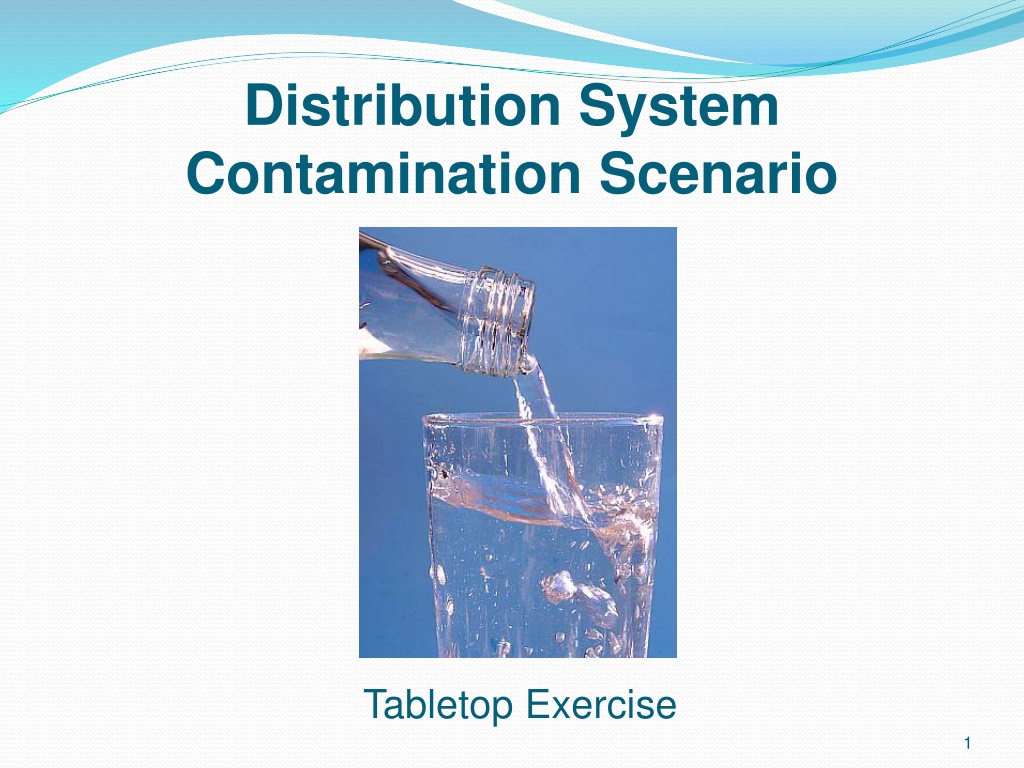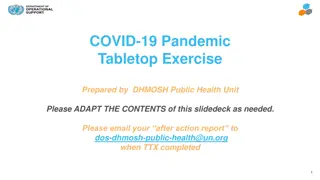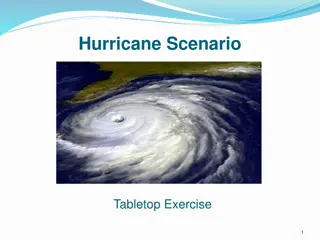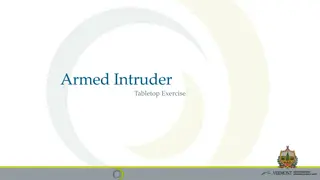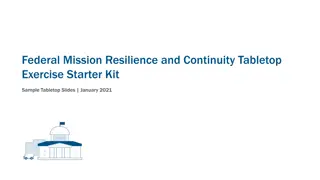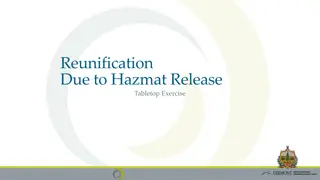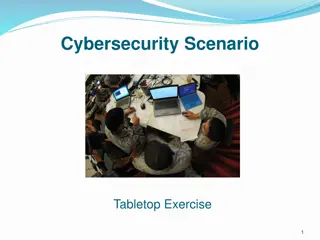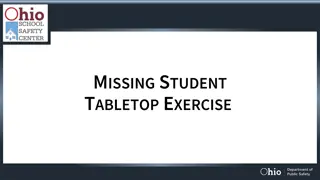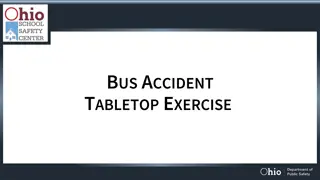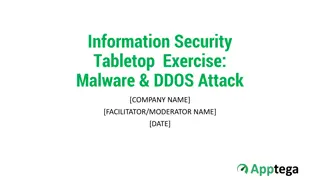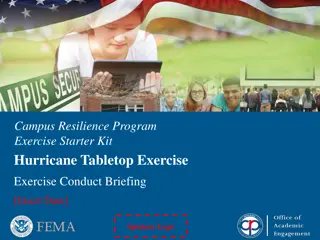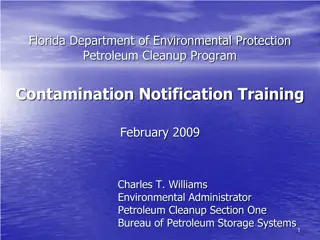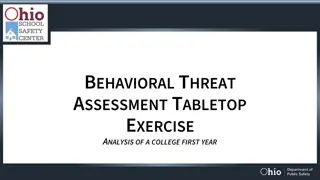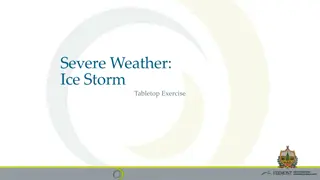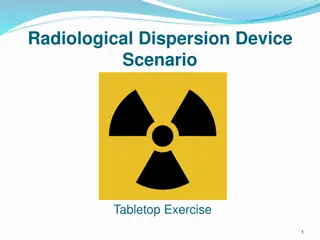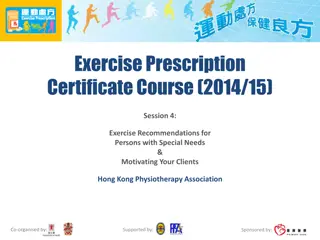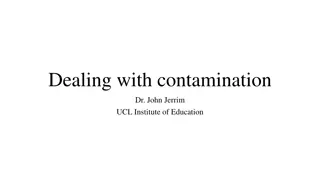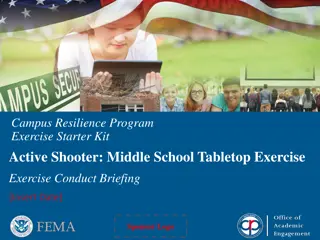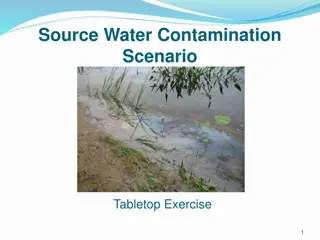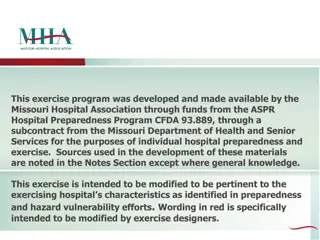Distribution System Contamination Tabletop Exercise Overview
This tabletop exercise focuses on simulating a distribution system contamination scenario to enhance emergency response preparedness. Participants engage in various activities like reviewing materials, facilitating discussions, and action planning to improve response capabilities. The exercise aims to increase readiness, assess response plans' effectiveness, and enhance individual and collective performance in a safe environment. By defining roles, building relationships, and identifying resource needs, participants can strengthen their response strategies.
Download Presentation

Please find below an Image/Link to download the presentation.
The content on the website is provided AS IS for your information and personal use only. It may not be sold, licensed, or shared on other websites without obtaining consent from the author. Download presentation by click this link. If you encounter any issues during the download, it is possible that the publisher has removed the file from their server.
E N D
Presentation Transcript
Distribution System Contamination Scenario Tabletop Exercise 1
Tabletop Exercise Welcome and introductions Discuss agenda for the day Review administrative details Start the exercise 2
Welcome and Introductions Name Organization Emergency response experience 3
Agenda Review exercise materials and rules Review scenario(s) Break Facilitated discussion period Action planning session ( hot wash ) Review and conclusion Closing comments 4
Administrative Details Location of emergency exits Location of restrooms Cell phone and pager management Logging your time to fulfill training requirements Sign-in sheet and participant evaluation form 5
Exercise Benefits: Increase readiness in the event of an actual emergency Provide a means to assess effectiveness of response plans and response capabilities Serve as a training tool for response personnel and their involvement with other response agencies Provide an opportunity to practice skills and improve individual performance in a non- threatening environment 6
Exercise Benefits: (cont.) Require participants to network with each other and pre-plan decisions on resources Identify planning conflicts or gaps Identify resource needs and opportunities for sharing of resources Clarify internal and external roles and responsibilities 7
Exercise Objectives: At the conclusion of this exercise, participants should be able to do the following: Define or refine participants roles and responsibilities for managing the consequences of a distribution system contamination incident, which should be reflected in their plans, policies and procedures and other preparedness elements currently in place or under development Build relationships between utilities and stakeholders 8
Exercise Objectives: (cont.) Determine neighboring utility water infrastructure capabilities and needs Identify other needed enhancements related to training and exercises and other preparedness elements currently in place or under development This session will not be a success unless you as a participant go back to your office and follow through 9
Roles and Responsibilities: Players respond to the situation presented based on expert knowledge of response procedures, current plans and procedures and insights derived from training and experience Observers observe the exercise but do not participate in the facilitated discussion period Facilitators lead the exercise by presenting the scenario narrative and facilitating the discussion period and hot wash (Action planning session or review session) Evaluators monitor the exercise, track accomplishments according to objectives and may ask questions 10
Exercise Rules: This exercise will be held in an open, low-stress, no- fault environment varying viewpoints, even disagreements, are expected Respond to the scenario using your knowledge of current plans and capabilities (i.e., you may use only existing assets) and insights derived from your training Decisions are not precedent setting and may not reflect your organization s final position on a given issue this exercise is an opportunity to discuss and present multiple options and possible solutions 11
Exercise Rules: (cont.) Issue identification is not as valuable as suggestions and recommended actions that could improve [prevention, protection, mitigation, response or recovery] efforts problem-solving efforts should be the focus Assume there will be cooperation and support from other responders and agencies The basis for discussion consists of the scenario narrative and modules, your experience, your understanding of your Emergency Response Plan (ERP), your intuition and other utility resources included as part of this material or that you brought with you Treat the scenario as if it will affect your area 12
Action Planning Session: Following the facilitated discussion period, the facilitator will lead an Action Planning Session, also known as a hot wash Participants are encouraged to identify, discuss and prioritize next steps, actions, tasks and other follow-up activities Identify additional collaborators if needed Schedule a follow-up meeting 13
Distribution System Contamination Scenario 14
Module 1 May 27 Contamination is Observed 15
Module 1 May 27,0700 hrs The customer service department of the town s water utility receives odor complaints from several local residents of the Buckhall neighborhood The complaints are coming from residents on different streets customers say their water smells skunk-like An operator is dispatched to investigate and obtain samples from hydrants and/or residential buildings once on site, the operator notices a strong, skunk-like smell in the samples 16
Key Issues Module 1 The origins of the taste and odor complaint calls are within a four-block radius The area where taste and odor complaints are coming from is mostly residential - businesses include a florist, a specialty foods store and a few other small retailers The utility uses free chlorine as the residual disinfectant 17
Module 2 May 27 Complaints Continue 18
Module 2 May 27,0900 hrs The local health department notes several unusual calls from the Buckhall neighborhood Callers are complaining of a skunk or garlic-like odor in the tap water, and some are also reporting feeling mild nausea and headache from the odor 19
Key Issues Module 2 The jurisdiction of the health department is entirely within the utility s service area and covers approximately 80% of the service area The local health department has key information that the utility would want to know Customer complaints continue to come into the utility from the Buckhall neighborhood 20
Module 3 May 27 The Contamination Source is Identified 21
Module 3 May 27,1100 hrs Through interviews, the utility operator and supervisor learn that the odor reminds residents of a smell they detect after lawn care workers have been by Both an ABC Lawn Care truck and a Fly-by-Night Lawn Care truck were spotted connected to fire hydrants early in the morning The companies care for several yards in the neighborhood, and ABC Lawn Care has a contract to maintain the town s public spaces No hydrant permit has been issued for Fly-by-Night Lawn Care in the last two weeks 22
Module 3 May 27,1100 hrs (cont.) A Fly-by-Night Lawn Care employee admits he did not obtain a permit to use the hydrant in Buckhall, and connected to it without a fire hydrant meter assembly He did use backflow prevention, but the device has not been maintained or inspected The worker used the hydrant to add water to a 300-gallon tank to dilute malathion Unintentional backflow is probably the cause for the odor complaints in the neighborhood 23
Key Issues Module 3 29 residences and six businesses were impacted by the contaminant Receiving a definitive analytical result for malathion in drinking water may take some time There are color change tickets that can screen for organophosphates Any concentrated malathion should be handled by HazMat teams, as skin contact can be hazardous 24
Module 4 May 28 The Contamination Extent is Determined 25
Module 4 May 28,1400 hrs Laboratory results reveal concentrations of malathion at up to 10.0 mg/L in the impacted area Malathion is a common insecticide According to EPA, the following levels of malathion in drinking water are not expected to cause harmful health effects: 0.2 mg/L for 1 day, 10 days, or longer-term exposure for children 0.1 mg/L for lifetime exposure of adults 26
Module 4 May 28,1400 hrs (cont.) The utility believes the contamination has been isolated to a five-block area of the Buckhall neighborhood A flushing plan is being developed to purge the malathion from the affected portion of the distribution system 27
Key Issues Module 4 Malathion exhibits a stickiness to copper and iron pipes Malathion does react with free chlorine Malaoxon is produced but it degrades rapidly Flushing of water from the system without additional treatment may pose a threat to the environment due to malathion s toxicity to wildlife 28
Module 5 May 29 The Contamination is Remediated 29
Module 5 May 29,0800 hrs The utility implements a flushing protocol to remove the affected water from the distribution system The mains will be flushed for three to six pipe volumes, but some malathion may stick to pipe walls Internal water fixtures of the impacted residences and buildings will also need flushing Water using appliances (e.g., ice and coffee makers) must be replaced 30
Key Issues Module 5 All residences and businesses have been notified of the identity and extent of the contamination The entire plumbing systems of several residences and businesses were contaminated during the incident Untreated water containing malathion that is removed from the system via flushing may pose a threat to wildlife 31
Action Planning Session Post-Exercise Hot Wash 32
Review of Exercise Objectives Explore and address cybersecurity challenges Define or refine participants roles and responsibilities for managing the consequences of a cybersecurity incident, which should be reflected in their plans, policies and procedures and other preparedness elements currently in place or under development Build relationships between utilities and stakeholders Increase awareness of the damage that can be caused by a cybersecurity incident on a business or control system Identify other needed enhancements related to training and exercises and other preparedness elements currently in place or under development 33
Conclusion Please turn in your notes from the Action Planning Session, your participant evaluation form and any additional comments you wish to share This information will be used to develop an After Action Report and Improvement Plan 34
Closing Remarks Thank you for participating 35
